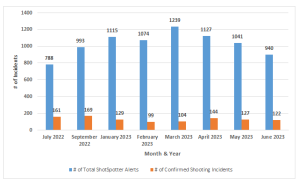Comptroller’s audit finds NYPD spent thousands of officer hours responding to unconfirmed ShotSpotter alerts
New York City Comptroller Brad Lander’s office released an audit of the New York Police Department (NYPD)’s use of ShotSpotter—an auditory gunfire location and detection technology—and found the alerts only identified confirmed shootings 13 percent of the time. The audit found that NYPD fails to make efficient use of its resources and officers’ time, and hold SoundThinking, Inc (aka ShotSpotter, Inc) accountable for the system’s extremely high rate of unfounded and unconfirmed shootings. The audit also found that the NYPD substantially overstates the reduction in response times achieved by using ShotSpotter.
“ShotSpotter claims to be ‘a proven detection system’ that is ‘faster and more accurate’, but our audit found that 87 percent of the time, ShotSpotter is sending NYPD officers in response to loud noises that don’t turn out to be confirmed shootings,” said Comptroller Brad Lander. “The evidence shows that NYPD is wasting precious time and money on this technology and needs to do a better job managing its resources. Chasing down car backfires and construction noise does not make us safer.”
The ShotSpotter system employs over 2,000 acoustic sensors to detect gunshot activity to assist NYPD in locating suspected gunfire within the five boroughs. Under their contract with the NYPD, the primary metric for ShotSpotter performance is to avoid “missed incidents:” ShotSpotter is expected to report 90% or more of probable shooting, thus gives them a strong incentive to over-report loud noises that do not turn out to be confirmed shootings.
For the eight months in 2022 and 2023 reviewed by the audit, these unconfirmed shootings ranged from 80% to 92% of ShotSpotter alerts, sending officers to investigate 7,262 incidents that did not turn out to be confirmed shootings.
NYPD records show that officers spent an average of 20 minutes investigating alerts deemed unfounded and 32 minutes investigating alerts that went unconfirmed. This translates to thousands of hours of officer time responding to ShotSpotter alerts that do not turn out to be confirmed shootings.
Number of Confirmed Shooting Incidents vs. Total ShotSpotter Alerts by Month

In addition, the audit found that ShotSpotter and the NYPD significantly overstate the reduction in response time that ShotSpotter facilitates – the primary value of the technology. While ShotSpotter markets a 5-minute difference between its detection system and emergency calls, the audit found that the average response time to ShotSpotter alerts was 1 minute 38 seconds faster than to 911 reports of outdoor gunfire.
More than 150 cities across the country use the technology, according to ShotSpotter. Major cities like Chicago, Atlanta, and Portland have decided against using the technology, with city officials and others describing it as “expensive, racially biased and ineffective.”
Comptroller Lander made five recommendations to the NYPD to address the audit findings. The NYPD rejected three and accepted two.
Recommendation #1: Decline to renew the ShotSpotter contract when it expires in December 2024 without first conducting a more thorough performance evaluation, considering the very low rates of confirmed shooting incidents detected, and factoring in the extensive NYPD officer time spent responding to alerts not ultimately confirmed as shootings.
- The NYPD claims, “it is not feasible to conduct an evaluation prior to the contract renewal period.”
Recommendation #2: Develop more meaningful performance standards of ShotSpotter’s accuracy that better factor in the very high rate of alerts not ultimately confirmed as shootings.
- NYPD suggested that data is not relevant to their considerations: “[W]here evidence is not recovered to confirm whether a shot was fired or not, it is not definitive proof that no crime has occurred, and it fails to acknowledge that the simple omnipresence of the Officers responding to the ShotSpotter alert dissuades further crime in and of itself. Omnipresence of Police Officers is a tactic that has been employed since the earliest days of law enforcement, however, in this case its reduction of crime is difficult to quantify.”
Recommendation #3: Collect and publish relevant data to increase transparency, including the number of published alerts, percentage of alerts that result in confirmed shootings, the number of false negatives and missed incidents, time and staff costs spent responding to alerts that are not ultimately confirmed as shootings, and the relative response times to ShotSpotter alerts versus 911 reports of shots fired outside.
- NYPD erroneously believes that the public would not understand the data: “Shooting numbers are ever changing based on investigations and other factors that follow the shootings and therefore, parties that are not familiar with the data could misinterpret the information.”
The NYPD did agree with the Comptroller’s office’s final two recommendations to follow up with ShotSpotter Inc. on coverage areas where the sensors did not meet the current contractually obligated standard, and to pay its invoices within 30 days, as mandated by procurement rules.
Comptroller Lander continued, “The NYPD’s response to these audit findings is disappointing and reflects a disinterest in using data, effective performance metrics, and transparency to improve public safety. With a thorough evaluation before deciding whether to renew this multi-million-dollar contract, better performance standards, and more transparency, the NYPD could deploy its resources – especially its officers’ time – far more effectively.”
Please find the Comptroller’s audit here.
No comments:
Post a Comment